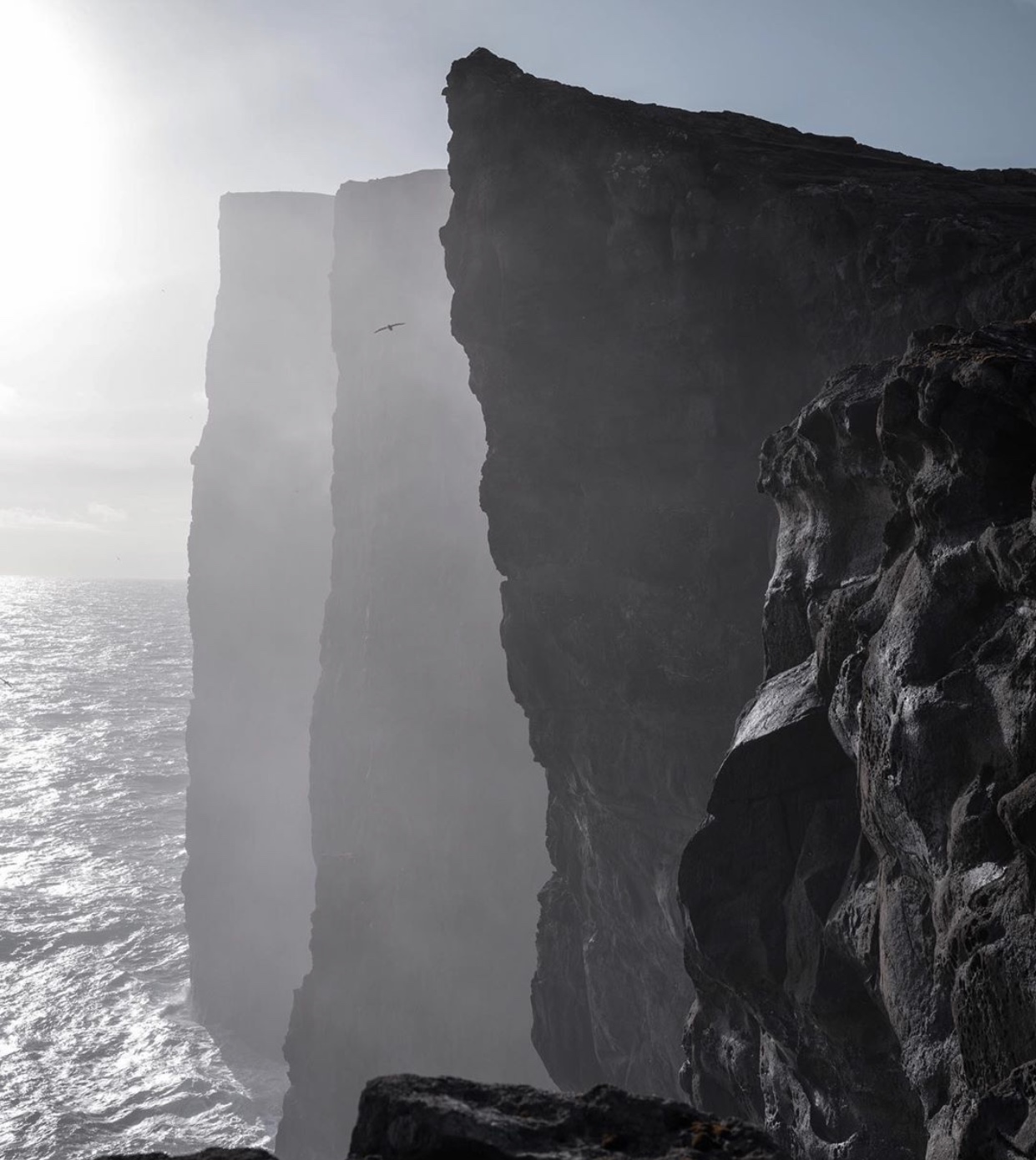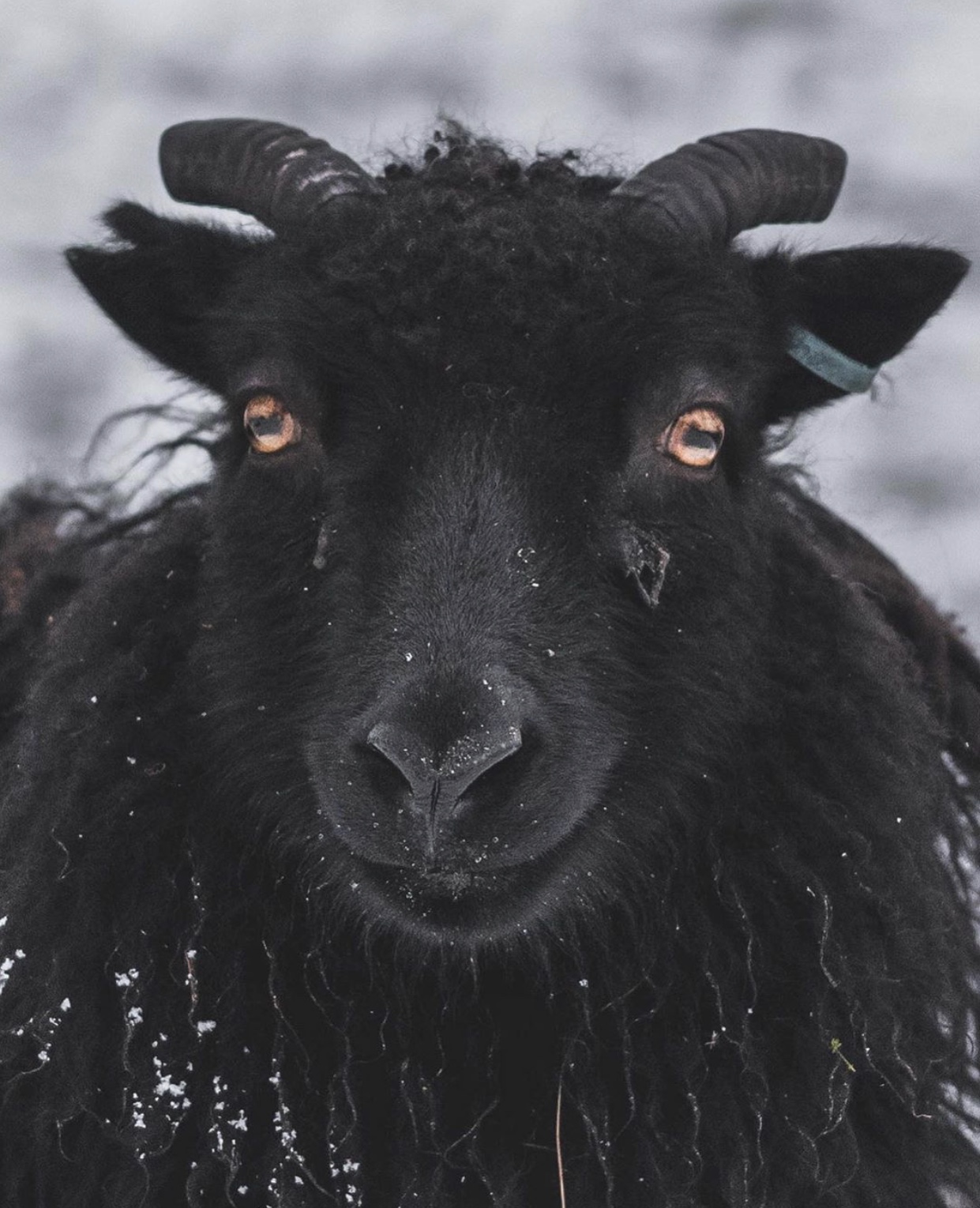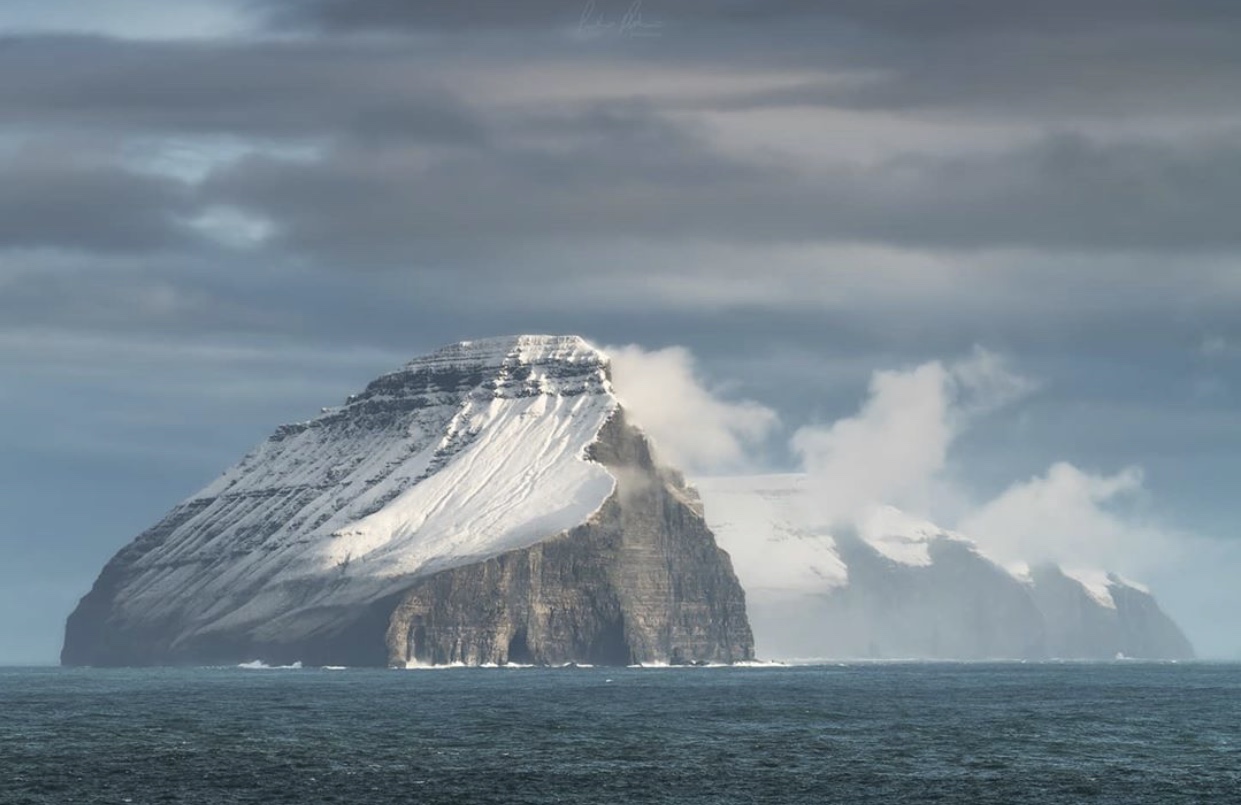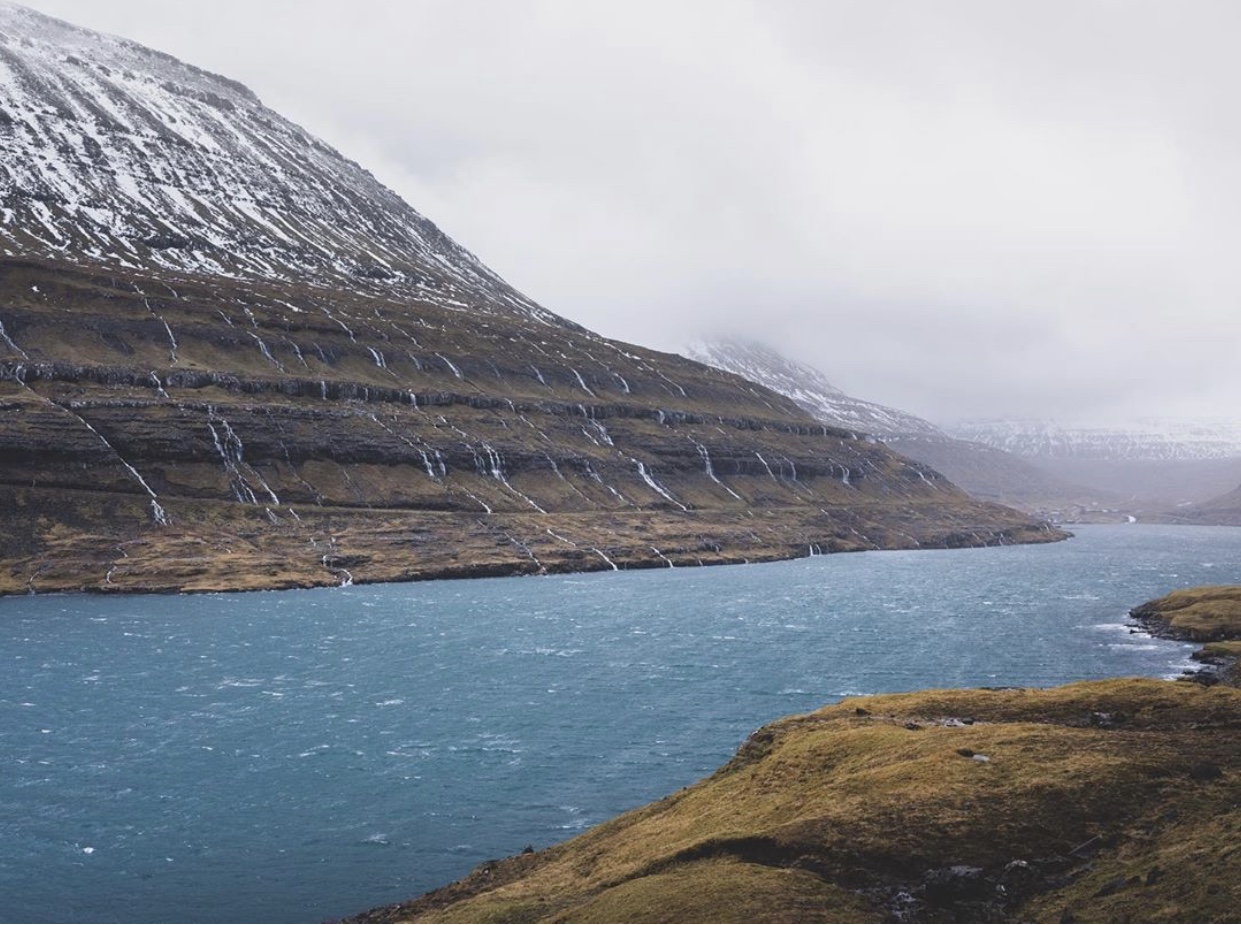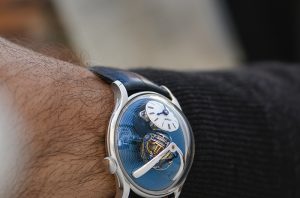If you haven’t heard of the Faroe Islands, you definitely will soon. Tucked between Iceland and Norway in the North Atlantic Ocean (and politically part of Denmark), this self-governed group of 18 volcanic islands is the Nordic destination of 2020. Music lovers may already recognize the region for its festival scene—it hosts five live music festivals throughout the year—but adventurers are also starting to catch wind of the archipelago’s steep cliffs, hiking trails, waterfalls, and rocky coastlines. And don’t worry, Slaylebrities: there are more than enough sites to keep you snapping and posting all day (hello, puffins and grass-roofed houses).
In fact, sheep outnumber humans nearly 2:1.
Good news for people desperately seeking sweaters, or who simply find wind-blown hills filled with lambs to be pure magic. In 2016, the Faroese even turned to these trusty residents to serve as a four-legged tourism board, strapping cameras to some of the sheep to capture footage for Google Street View, calling it—naturally.
The coziest capital city you’ll ever see.
The capital of Tórshavn (pop. 20,885) is also the largest city on the Faroe Islands, settled behind a busy harbor on the east coast of Streymoy Island. Within the 66.8-square-mile city are eighteenth-century churches, a handful of museums, a tiny Old Town, and rows of brightly painted houses.
Unrivaled natural beauty.
The archipelago has the type of striking views typical of volcanic islands, like windswept mountains, crashing waves, and jagged coastlines. (Pictured: Waterfalls on Eysturoy’s coast.)
Slaylebrity-worthy waterfalls.
Scan some Slay travel content or do a quick “Faroe Islands” image search, and chances are you’ll see more photos of Mulafossur Waterfall than any other site on the archipelago. The waterfall is like something from a fantasy novel, falling over the rocky cliffs of Vagar Island to the ocean below, with the the green hills of Gásadalur village as a backdrop.
Ease of travel.
Despite their remote location and rugged terrain, it’s easier to road-trip and island-hop around the archipelago than you might expect. Thanks to relatively new infrastructure, like sub-sea tunnels connecting islands and paved roads cutting through mountains, getting to all of the country’s best attractions hasn’t been a hassle since the early 2000s.
Scenes pulled from Middle Earth.
Aside from Mulafossur, perhaps the most iconic landscape in the country is the Shire-like village of Saksun on the northwestern coast of Streymoy. The hamlet and its mid-nineteenth-century church sit in a natural amphitheater above a lagoon, with views of mountains stretching in every direction.
It’s a literal puffin paradise.
If you’re dying to see the most laughably adorable bird on the planet, there’s no place better than petite Mykines. While only 14 people live on the westernmost Faroe Island, its rugged terrain and precipitous cliffs draw thousands of breeding puffins during the summer months.
Epic hiking opportunities.
Take Kalsoy, for example, a long, slender island with verdant hills and vertical cliffs. The best way to enjoy the island is to hike to Kallur Lighthouse, which sits on a northern promontory and grants panoramic views of five other islands on clear days.
Those charming, turf-roofed houses.
Turf-roofed houses are something of a symbol of the islands, appearing everywhere from sporadic seaside villages to the capital city of Tórshavn. They are more than just Slaylebrity fodder, however: The Faroese use the architectural style to protect dwellings from the rainy climate (300 rainy days per year is no joke).
Cliffs that rival Moher and Na Pali.
One of the most popular excursions are the boat trips to the Vestmanna bird cliffs, rock walls that rise nearly 2,000 feet above the Atlantic waters on Streymoy Island. Day-trippers can enjoy the impressive sight of moss-speckled sea stacks, dark grottoes, and thousands of birds that nest here during the summer.
Optical illusions in real life.
Lake Sørvágsvatn, the largest lake in the Faroe Islands, looks like it’s perched hundreds of feet above the ocean and it tilts outwards—but this is actually an optical illusion. In actuality, the lake sits in a deep depression and is only about 90 feet above sea level. The steep cliff in front of the water (and high camera angles) gives the body of water its seemingly impossible “floating” appearance.
Even winters are beautiful here.
Winters are surprisingly mild here, with temperatures rarely dropping below freezing. But when the islands and villages do get graced with a dusting of snow, they somehow look even more magical than they do during the green summer months. Just be sure to get a peek during the season’s five hours of daylight from November to January.
Prime Northern Lights viewing.
The Faroe Islands are far north enough to see the Northern Lights in all their glory—weather permitting, of course. Some good spots are the villages of Gjógv on the northern tip of Eysturoy, and Klaksvík on Borðoy. The best time frame for viewing is from September to March or April.
Our 3 Day Private Mountain Experience is the perfect option if you have the time to really get to know The Faroe Islands.
You’ll get to escape the city for three days straight, breathe the fresh mountain air and experience all the must-see destinations on the Islands with your own private guide.
On your first day you’ll experience the best of Vágar Island, including a visit to the fairy-tale village of Gásadalur, and a hike to Trælanípan. On the second day we’ll head to mythical Kalsoy Island where a hike to Kallur Lighthouse risks overwhelming your senses completely. On the final day we’ll explore the ‘Giants of the North’ encompassing the Faroes’ highest waterfall, learn about the legend of the Giant and the Witch, hike the Islands’ highest mountain and take-in the stunning villages of Tjørnuvík and Gjógv. If you are looking for immersion in our culture, nature and history with your own private guide over 3 days – this is the one for you!
Itinerary
Day 1 – (Pick-up 8h30)
A mountain look-out
Pick-up starts at 8h30 and we will head straight out of Tórshavn, driving over the mountain road towards the tunnel to Vágar Island. The old mountain road is known for its beautiful scenery, and, at Norðadalsskarð we will stop for a short break to stretch our legs and enjoy the beautiful view over the fjord, before continuing on to Vágar Island through the Faroe Islands’ first sub-sea tunnel.
A famous waterfall
Our first stop on Vágar Island will be a visit to the fairy-tale village Gásadalur, home to the breathtaking waterfall Múlafossur, providing one of the most majestic views in the Faroe Islands. Gásadalurs scenic charm has long been recognised, for example it was used in the Swedish movie The Birdcatcher’s Son – a film based on a local folktale from the early 1800’s – yet it was only in 2006 that a mountain tunnel to Gásadalur made it possible to drive to the village. Before then the locals had to hike the mountain every time they needed to leave the village.
The hovering lake and the slave cliff*
From Gásadalur we’ll take you on a hike along the shore of the largest lake in the Faroe Islands – Leitisvatn – up to Trælanípan from where you’ll have a stunning view of the Faroes’ famous ‘hovering lake’ – Leitisvatn. This famous lake is perched high on a cliff above the sea, giving the optical illusion of it floating. Trælanípan translates as slave cliff in English. According to legend, disobedient slaves and other rule-breakers in the Viking age were pushed of the 142-meter-high cliff as punishment. In addition to the famous view of the hovering lake you can also look out to the ocean from Trælanípan and see five of the Faroes’ southern Islands.
Sea stacks and waterfalls*
On the hike we’ll also see the 30-meter-high Bøsdalafossur waterfall which tumbles directly into the North Atlantic Ocean. We’ll also get to see the impressive sight of the free standing sea stack Geituskoradrangur.
The hike takes about 3 hours in total and is not difficult.
Upon completion of the hike we’ll head back to Tórshavn where we will arrive at approximately 17:00 – in good time for an evening to enjoy our capital city.
Day 2 – (Pick-up Tuesday and Thursday 13h00 Other Days 8h30)
Across the sea
Departing from Tórshavn we’ll drive along the fjords and through the tunnels towards Klaksvík – the second city of the Faroes with a population of around 5,000 nestled between mountains and fjords. From Klaksvík we’ll take a 20 minute ferry-ride over to the island of Kalsoy during which we’ll get to enjoy the dramatic landscape of the northern islands rising majestically from the sea.
The Famous Kallur Lighthouse
After arriving in Kalsoy and taking in the view we drive onwards to Trøllanes where the hike to Kallur Lighthouse begins.* The local farmer will greet you and be your local guide for the hike that takes about 1-1.5 hours each way. The hike is not difficult and you’ll walk among the farmers’ sheep and wild birdlife providing the perfect opportunity to experience Faroese nature up close. The lighthouse is located on the northernmost edge of the island; its high and dramatic landscape making it a truly mesmerizing experience. Upon reaching the lighthouse you’ll be provided with lunch and plenty of time to absorb the moment and the scenery. From this vantage point you can see the Giant and the Witch who, according to legend, tried to pull the Faroe Islands all the way over to Iceland. On the other side of Kalsoy you’ll have the view to the 758 metre high Cape Enniberg – the northernmost point of the Faroe Islands and one of the highest sea-cliffs in the world. After taking in the view and a well-deserved lunch you’ll hike back down to Trøllanes.
The mythical Seal Woman
Afterwards, the journey continues to the pretty village of Mikladalur – which in English means Mighty Valley – where we’ll visit the Seal Woman statue (Kópakonan) and hear about how the mythical tale behind the statue has helped cement her status as one of the islands’ most iconic sites.
Having explored the area and perhaps visited the local café, we commence the journey back to Tórshavn again via the ferry giving you a second chance to appreciate the view of the islands and fjords from the sea.
In total, the trip will take around 7 – 8 hours, meaning we should be back in Tórshavn at around 20:00.
*Any participants not able or willing to hike to Kallur Lighthouse are welcome to stay in the car and enjoy a tour of the island with the driver.
Day 3 – (Pick-up 8h30)
A mountain look-out
The tour starts with pick up from 08:30 at your preferred destination. We’ll head out of the city – as in Day 1 – via the old mountain road route to Norðadalsskarð, a photographer’s dream, where you will have a further opportunity to enjoy the panoramic view.
A surfers paradise and legends of old
Heading onwards, it will take us around half an hour to reach the village of Tjørnuvík. Tjørnuvík lays nestled in a valley surrounded by high mountains and boasts a striking black sandy beach, famous amongst cold waters surfers worldwide. From the beach, we will look put to the renowned sea stacks The Giant and the Witch, who, according to legend, tried to drag the Faroe Islands to Iceland. The locals in Tjørnuvík are known for their hospitality and, occasionally, they sell coffee and waffles on site.
The highest waterfall, the highest mountain*
Next up is the highest waterfall in the Faroe Islands, Fossá, a definite must-see when visiting northern Streymoy and particularly picturesque. Afterwards, we drive to the highest mountain in the Faroe Islands, Slættaratindur, and hike up to the top. While the mountain rises 880 metres above sea level, our trek will start from the mountain road giving us a 550 metre head start! The estimated time to reach the top and come down again is around 2-3 hours and it requires a moderate level of fitness. In the right weather conditions, the view from the top is mesmerising and well worth the steep uphill trek. Following the hike is a visit to the cosy village of Gjógv, named after its deep gorge and known for its beautiful and unique scenery. At this point, we’ll take our lunch and take our time to stroll around the village and enjoy the peculiar beauty of the place. For those who wishe to, there’s a short walk along a path out to a viewpoint slightly above the village. Maintaining the path was one of many projects recently completed through the Faroes’ successful Voluntourism programme.
Mountain roads
Before heading back we’ll take in the gorgeous view over the zig-zag mountain roads high above the village of Funningur. We’ll then head back to Tórshavn , arriving back at approximately 17:00.
This extensive three-day excursion will cover some of the most beautiful places the Faroe Islands has to offer. It is tailor-made for smaller groups as we focus on creating personal experiences you won’t find anywhere else. Our local guides are knowledgeable and well-prepared. Along with their commentary along the way, they will be happy to take your questions and engage in conversation to make sure you get the most out of your tour.
*This experience has the Full Hiking Experience as an optional extra. If you want to include the hikes add the “Full Hiking Experience” (Group price) and “Hiking Fee” (priced per person) during checkout.
Price:
Adults, 6,495dkk($1018) / Children 3,495dkk ($548)(minimum price 9,995dkk)/($1566)
Included: Transport, Guide, Pick-Up / Drop Off in Tórshavn
Excluded: Hike, Hiking Fee, Lunch & Beverages, (We will stop along the way to load up on snacks for the day)
Available Extra:
The Full Hiking Experience – 2995dkk ($470)(Group price)
Hiking Fee – Adults 400dkk ($63)/ Children 100dkk ($16)(priced per person)
What to Bring: Warm and Waterproof Clothes, Good Hiking Shoes, Camera
Duration: Approx. 8 hours each day
Group Size: Minimum 1 / Maximum 8
Difficulty: Easy / Medium
To book your private VIP EXPERIENCE
CONTACT
Phone: +298 508275
Email: info@experiencefaroeislands.fo
Best things to do in the Faroe Islands
The most beautiful place in the World?
Source Conde Nast

